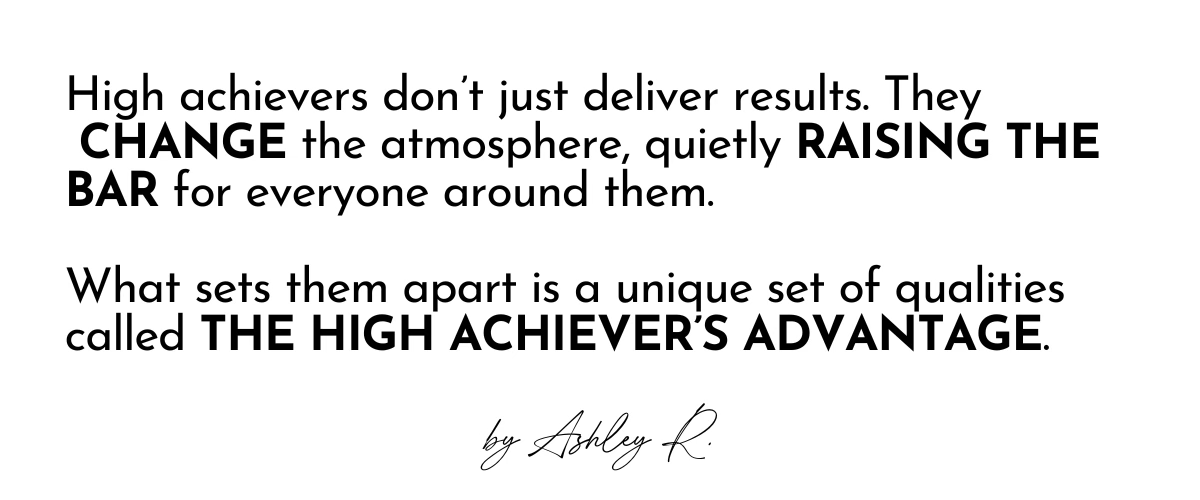The High Achiever’s Advantage
The 5 qualities that separate good employees from game-changers and how to know if you (or one of your employees) is game changer.
Welcome to this week’s edition of Reframed by Ashley R. I write for high achieving professionals who rarely get the space to think through what they want next or how to lead in a way that actually works for them.
I'm Ashley Rudolph—a former tech executive turned coach for leaders and next-gen execs in the creative, tech, and lifestyle industries.
SETTING THE SCENE: STORY TIME
Sometimes I start my engagements by having my high-achieving clients walk me through their proudest professional moments. You might be surprised to hear that many of them are stumped by the task at first. Then, after a bit of back and forth, I start to uncover the award-winning, department-shifting, revenue-boosting, efficiency gaining, crisis-averting work they all inevitably do.
I recently started working with a new client and the start of our coaching relationship played out exactly like the above. I asked her what her proudest professional achievements were. She asked me to give her some time to think. A few minutes went by. She shared three. I asked a few follow-up questions out of curiosity and her responses blew me away. Her work received the type of accolades that some people spend entire careers chasing and most will never come close to receiving, and yet, I had to ask multiple follow-up questions before even learning about them! They weren’t central in her success narrative, she almost brushed them aside as if they were incidental. She was simply driven by her desire to help others, to do great work, and to create a lifestyle she enjoyed. And as a result, her work product was stellar.
Thinking about her made me reflect on the qualities all my high-achieving clients share. The intangibles. The things often overlooked but critical to what makes them extraordinary.
I call this formula The High Achiever’s Advantage. It’s made up of 5 pillars: drive, self-efficacy, intuition, connection, and execution. Each of these pillars is worth a deep dive on its own as evidenced by highly popular books like “Drive” by Daniel H. Pink, “Mindset: The New Psychology of Success” by Carol Dweck, and “The 4 Disciplines of Execution” by Chris McChesney, to name a few. Time and time again in my work, I encounter incredibly talented professionals that have all 5 of the pillars that make up the High Achiever’s Advantage. And I’d argue that the combination of them all create the “it factor” that high achievers have. The “it factor” behind the unbelievable results they deliver. Every single time.
Let’s dig in.
THE HIGH ACHIEVER’S ADVANTAGE UNLOCKED: STRATEGIES & TACTICS
1. Drive
Have you ever worked with someone who just had an insatiable will to succeed? They probably had high drive. High achievers possess a self-determined fire—a relentless internal drive that pushes them forward without the need for constant direction or external validation. Psychologists call this intrinsic motivation, and it’s tied to higher levels of productivity and engagement. It’s not just about ambition; it’s about purpose.
Without drive, teams can feel stuck in a constant loop of inertia—waiting for the next instruction, hesitating to take the first step. If you’ve ever worked on a team like this, you probably know how stagnant that kind of energy feels and that progress can feel like pulling teeth. High achievers, on the other hand, don’t wait for a roadmap. They create one. They thrive in ambiguity and can find opportunities where others see obstacles.
And when this drive is present on a team? It changes everything. The momentum is palpable. You’ll see it in how projects pick up speed, in how even the most resistant team members begin to match the pace. Drive isn’t loud or boastful, but its impact is undeniable—it’s the quiet, steady hum of progress that keeps everyone moving forward.
WORK WITH ME
→ Ready for a smarter strategy behind your next move?
That’s the work we do inside Elevate — a one-on-one coaching experience for high performers navigating career pivots, leadership growth, or defining what’s next.
2. Self-Efficacy
Most people would attempt to sum up the next pillar as confidence and that’s partially true. Self-efficacy, a term coined by psychologist Albert Bandura, is the belief in one’s ability to achieve specific outcomes. It’s not about arrogance; it’s a deep-seated trust in your skills and your ability to figure things out. High achievers don’t crumble at the first sign of a setback because they know they can find a way through. You give a high achiever a goal and they’ll likely report back once it’s done, if at all (lol).
Now, imagine a team without someone who possesses this kind of confidence. Doubts creep in. Decisions are second-guessed (hello analysis paralysis — we see you!). Progress slows because no one is willing to take the lead. You put a high achiever on the team and the dynamic shifts. They bring a grounded certainty to the room that changes how challenges are approached.
When self-efficacy is present, it creates an unspoken ripple effect. Teams stop saying things like “we can’t do that” and start saying “we will.” That subtle shift in language? That’s the impact of having a high achiever who believes, deeply and genuinely, that success isn’t just possible—it’s inevitable.
3. Intuition
Nine times out of ten, when I ask my high achieving clients how they do what they do, I often get a shrug and a simple answer: “I just know.” What they’re describing isn’t luck; it’s tacit knowledge—the ability to make quick, sound decisions based on patterns they’ve internalized through years of experience. They trust their gut because it’s earned that trust.
A team member with battle tested intuition saves teams from over-analysis. Teams without this kind of intuition feel… well, chaotic. Decisions drag on because every option feels equally valid, and accountability becomes a game of hot potato. High achievers? They cut through that noise. They bring clarity and confidence to moments of uncertainty.
On a team, their intuition creates calm. Their intuition isn’t arrogance, it also doesn’t look like the person that swoops in as a savior, controlling everyone’s next steps—it’s an earned confidence that allows others to breathe easier. They know someone has their eye on the horizon, anticipating what’s next and quietly steering them toward it.
4. Connection
One of the most surprising qualities of high achievers is their ability to build genuine, meaningful connections. You can be smart, you can be talented, you can be well-researched, you can be a scholar but you’re not a high achiever if you don’t possess the ability to connect with others. High achievers bring people together. They’re not the lone wolves or the “callous geniuses” who alienate everyone with their brilliance. (We’ve all worked with that person—great for headlines, terrible for morale.) Instead, they’re skilled at building rapport, inspiring trust, and creating an environment where people feel valued and seen. Research calls this emotional intelligence—the ability to understand, manage, and respond to emotions. I call it the secret sauce of high performance.
When this kind of connection is missing, teams can feel fragmented. You see it in passive-aggressive emails, in side-eyes during meetings, in the unspoken tension that makes collaboration feel like a chore. High achievers transform that energy. They create a culture where people want to show up and do their best work—not because they have to, but because they’re inspired to.
This ability to connect changes the game. Like I said before it’s not just about being smart or capable—it’s about making the work feel exciting, meaningful, and human.
5. Execution
This is the cornerstone of high achievers. Without execution, all the other qualities I mention fall flat. High achievers don’t just dream big; they deliver. Consistently. Efficiently. Often with a grace that makes it all look effortless.
Teams without strong executors struggle to follow through on big ideas. Deadlines get missed, and frustration builds as good intentions fail to materialize into results. High achievers, on the other hand, prioritize ruthlessly and push projects across the finish line, no matter the obstacles.
On a team, this level of execution builds trust. Deadlines are met, goals are achieved, and a sense of reliability takes root. When high achievers lead the charge, people stop doubting what’s possible. They start believing.
The High Achiever’s Advantage
I’ve dedicated almost all of my time and energy to supporting high achievers. I’ve also come to realize that if any of the above pillars are “blocked” it prevents high achievers from achieving (it’s possible!). It triggers a rebirth in a sense— to a new career, a new company, a new city, you name it.
Those five pillars (Drive, Self-Efficacy, Intuition, Connection, and Execution) are the foundation of incredible performance. The High Achiever’s Advantage framework doesn’t just define success, it elevates everyone around them.
If you work alongside a high achiever, you’ll feel it in the way your team moves. If you see yourself in these pillars, take a moment to reflect: How are you leaning into them? And how can you unlock even more of your High Achiever’s Advantage?
Resources
If you’re looking to level up your leadership — here’s some resources!
If you’re planning for next year and want to reflect on your own opportunities for growth and ways to continue leveraging your strengths, download my Year-End Planning Guide. It has tools to help you lead with purpose and leverage your strengths next year and beyond.
If you’re looking for support in building resilience, listen to the most recent episode of my podcast, The Impactful Conversations Effect, with Lea Durante.
SUBSCRIBE
→ Already subscribed? You’re in good company.
My readers work at places like A24, DoorDash, IDEO, Disney, and Harvard — and they’re all here for the same reason: to lead with more clarity, confidence, and intention.
If you’re not subscribed, click the subscribe button below.




